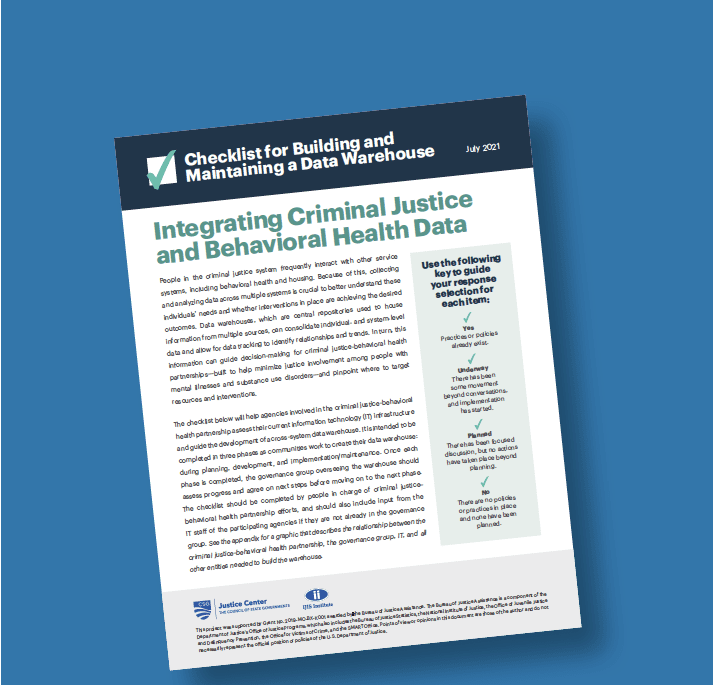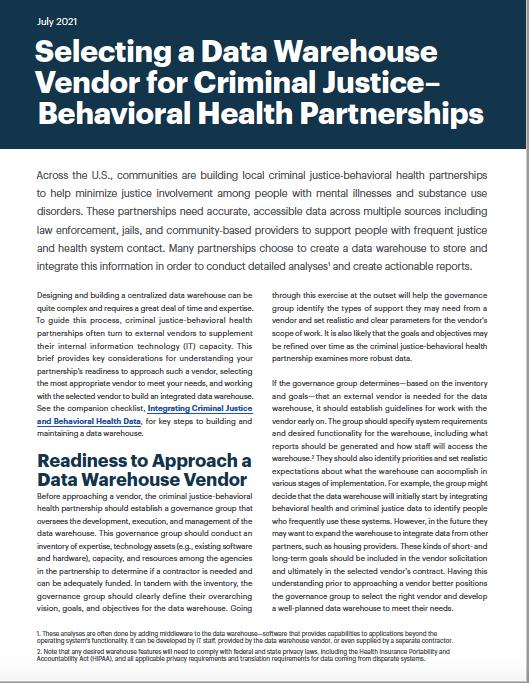Selecting a Data Warehouse Vendor for Criminal Justice-Behavioral Health Partnerships
Selecting a Data Warehouse Vendor for Criminal Justice-Behavioral Health Partnerships
Designing and building a centralized data warehouse can be quite complex and requires a great deal of time and expertise. To guide this process, criminal justice-behavioral health partnerships often turn to external vendors to supplement their internal information technology capacity. This brief provides key considerations for understanding your partnership’s readiness to approach such a vendor, selecting the most appropriate vendor to meet your needs, and working with the selected vendor to build an integrated data warehouse.
Across the U.S., communities are building local criminal justice-behavioral health partnerships to help minimize justice involvement among people with mental illnesses and substance use disorders. These partnerships need accurate, accessible data across multiple sources including law enforcement, jails, and community-based providers to support people with frequent justice and health system contact. Many partnerships choose to create a data warehouse to store and integrate this information in order to conduct detailed analyses1 and create actionable reports.
Designing and building a centralized data warehouse can be quite complex and requires a great deal of time and expertise. To guide this process, criminal justice-behavioral health partnerships often turn to external vendors to supplement their internal information technology (IT) capacity. This brief provides key considerations for understanding your partnership’s readiness to approach such a vendor, selecting the most appropriate vendor to meet your needs, and working with the selected vendor to build an integrated data warehouse. See the companion checklist, Integrating Criminal Justice and Behavioral Health Data, for key steps to building and maintaining a data warehouse.
Readiness to Approach a Data Warehouse Vendor
Before approaching a vendor, the criminal justice-behavioral health partnership should establish a governance group that oversees the development, execution and management of the data warehouse. This governance group should conduct an inventory of expertise, technology assets (e.g., existing software and hardware), capacity, and resources among the agencies in the partnership to determine if a contractor is needed and can be adequately funded. In tandem with the inventory, the governance group should clearly define their overarching vision, goals, and objectives for the data warehouse. Going through this exercise at the outset will help the governance group identify the types of support they may need from a vendor and set realistic and clear parameters for the vendor’s scope of work. It is also likely that the goals and objectives may be refined over time as the criminal justice-behavioral health partnership examines more robust data.
If the governance group determines—based on the inventory and goals—that an external vendor is needed for the data warehouse, it should establish guidelines for work with the vendor early on. The group should specify system requirements and desired functionality for the warehouse, including what reports should be generated and how staff will access the warehouse.2 They should also identify priorities and set realistic expectations about what the warehouse can accomplish in various stages of implementation. For example, the group might decide that the data warehouse will initially start by integrating behavioral health and criminal justice data to identify people who frequently use these systems. However, in the future, they may want to expand the warehouse to integrate data from other partners, such as housing providers. These kinds of short- and long-term goals should be included in the vendor solicitation and ultimately in the selected vendor’s contract. Having this understanding prior to approaching a vendor better positions the governance group to select the right vendor and develop a well-planned data warehouse to meet their needs.
Vendor Selection
Selecting the best vendor to build your data warehouse is highly dependent on how much information the governance group provides in the solicitation to ensure that proposals meet the needs of the project. However, even with a detailed explanation of the group’s desired functionality and warehouse goals, other obstacles (such as difficulty in communicating needs across multiple agencies and forms of government) can extend the time it takes to select a vendor. The following steps can help the governance group fast-track a successful vendor selection process:

COMPLETE PHASE 1: Planning for a Data Warehouse in the companion checklist to assess your criminal justice-behavioral health partnership’s readiness for approaching a vendor.
1. Do your research.
Before drafting a solicitation for a vendor, talk with a peer jurisdiction that went through a data integration project. Ask them what went well with the project and what they would’ve done differently. While you may not want to replicate the peer’s system features and requirements exactly, you will benefit from gaining insight from groups who have already gone through this process.
2. Craft a comprehensive vendor solicitation.
The county or lead agency that has been tapped to coordinate with and manage the vendor should release a detailed request for proposals (RFP) through its procurement office. The RFP should describe the purpose and general functionality of the data warehouse, outline desired access and security requirements, and provide information about the participating agencies and timelines. Be careful not to prescribe the technology solution for building the warehouse so that vendors are able to offer the best and most up-to-date solution available to meet your needs. Additionally, the RFP should encourage the vendor to suggest creative solutions to meet the goals of the warehouse as long as they are manageable for local IT staff to maintain and enhance. Part of the solicitation should also ask vendors to include sample reports that could be generated, particularly in light of any middleware plans they have for the data warehouse.3 Lastly, when the procurement office prepares the solicitation, be sure to review and negotiate the essential components that need to be included in the final RFP, as this process can often remove critical information necessary for vendors to effectively respond to the solicitation.
3. Jointly review applicants
While the proposal review process will likely be dictated by local procurement requirements, the governance group can establish a subcommittee to jointly review all proposals with clear, objective criteria in mind to provide recommendations to the procurement office’s selection group. When reviewing proposals, avoid selecting vendors based on word of mouth, general sales pitches, or personal relationships. As part of the selection process, the governance group or subcommittee may also want to include a scenario-based assessment for final candidates. The assessment may include an in-person presentation describing how the vendor would establish a project plan for building the data warehouse or their approach to security and privacy, especially how they plan to manage HIPAA requirements and protect other critical information.
4. Check references
When final candidates are identified, be sure to contact one or two other companies/agencies that the vendor previously worked with—preferably where they integrated health and justice data and understood requisite privacy regulations. As with any selection process, references are a great way to better understand what the vendor has accomplished and what kind of relationship you might expect to have with them.
Management of Vendor Relationships
Once the vendor is selected, the governance group must effectively manage this relationship and oversee the vendor’s work to ensure that it stays within scope and budget. This implementation management begins with identifying a project manager to liaise with the vendor. A subcommittee can also be formed with local IT and operational staff to inform the work. However, all contact with the vendor should flow through one project manager to improve efficiency and simplify the exchange of information. The following steps can help the governance group successfully manage a vendor relationship:
1. Agree on contract terms
After selecting the vendor, the governance group will want to negotiate the contract between the vendor and the lead agency that has been given the authority to hire and manage the vendor. At a minimum, the contract should include clear language on the timeline for the development of the data warehouse, plans for regular engagement with the governance group, functionality and system requirements, maintenance and hosting obligations, and a process for change orders.4 It should also make clear how the vendor will ensure quality assurance, how to process help tickets, what training will be included for IT staff and existing and new employees of the participating agencies, how to make ad hoc report requests, and responsibilities for the vendor and for local IT staff.5 Once all necessary language is included, the lead agency should review the general contract terms with the governance group to get input and feedback before it is finalized.
2. Develop an ongoing maintenance agreement
When included in the vendor contract, this agreement protects the criminal justice-behavioral health partnership against losing ongoing maintenance support for the data warehouse. As new software products are developed, support for older technology that may have been outlined in the initial contract is sometimes phased out. Therefore, the maintenance and support section of the contract should stipulate that the vendor will support the warehouse and related software for a minimum of three years and any plans for updating their software as appropriate. If this is not feasible, the governance group should obtain a timeline from the vendor for how long they will support the warehouse and update security requirements.
3. Create a comprehensive work plan
This work plan should guide the development of the data warehouse and build off the short- and long-term goals that align with the strategic objectives of the broader criminal justice-behavioral health partnership. It should also include input from IT staff across participating agencies and outline tasks, timelines, roles and responsibilities, and budget allocations.
4. Maintain regular contact with the vendor
The project manager should serve as the lead liaison with the vendor and regularly report back to the governance group on progress and changes to the work plan. With input from the governance group, the project manager can determine how often this contact should occur and what the reports will include.
5. Establish a schedule for data warehouse demonstrations
During key points in development and implementation, the vendor should conduct training and demonstrations with the governance group. This will allow the group to see the functionality of the warehouse and inform development along the way. Ultimately, this process will lead to strong buy-in and implementation of the data warehouse.
6. Conduct user tests
Any development of a data warehouse will need to include a significant amount of time for beta testing by end-users to identify any kinks and bugs in the system before being implemented with agency staff. This should include testing data uploads, data outputs, dashboards, and user interfaces from each participating agency’s respective systems. Role-based access should also be tested to ensure that security and access are appropriate relative to what each person needs to be able to see based on their work function and credentials.
Footnotes
1These analyses are often done by adding middleware to the data warehouse—software that provides capabilities to applications beyond the
operating system’s functionality. It can be developed by IT staff, provided by the data warehouse vendor, or even supplied by a separate contractor.
2Note that any desired warehouse features will need to comply with federal and state privacy laws, including the Health Insurance Portability and
Accountability Act (HIPAA), and all applicable privacy requirements and translation requirements for data coming from disparate systems.
3Some vendors will build middleware into the data warehouse, while others will allow you to purchase your own middleware, which can sometimes be
cheaper. Ask that proposals provide options for both to see what you might save if you implement middleware through a separate process.
4Change orders are used to amend a contract when project plans or deliverables shift and, as a result, the scope and hours of a project need to be changed.
5Some of these items can and should be managed by local IT staff, but vendor contracts should at a minimum specify what will be maintained by participating agency staff and include training for them.

This project was supported by Grant No. 2019-MO-BX-K001 awarded by the Bureau of Justice Assistance. The Bureau of Justice Assistance is a component of the Department of Justice’s Office of Justice Programs, which also includes the Bureau of Justice Statistics, the National Institute of Justice, the Office of Juvenile Justice and Delinquency Prevention, the Office for Victims of Crime, and the SMART Office. Points of view or opinions in this document are those of the author and do not necessarily represent the official position or policies of the U.S. Department of Justice.
Project Credits
Writing: Stephanie Shaw, CSG Justice Center, and Robert May, Integrated Justice Information Systems Institute
Research: Robert May, Integrated Justice Information Systems Institute, and Stephanie Shaw, CSG Justice Center
Advising: Risë Haneberg, CSG Justice Center
Editing: Darby Baham and Emily Morgan, CSG Justice Center
Design: Michael Bierman
Public Affairs: Ruvi Lopez, CSG Justice Center
ABOUT THE AUTHOR
The sharp rise in school shootings over the past 25 years has led school officials across the U.S.…
Read MoreA three-digit crisis line, 988, launched two years ago to supplement—not necessarily replace—911. Calling 988 simplifies access to…
Read More Taking the HEAT Out of Campus Crises: A Proactive Approach to College Safety
Taking the HEAT Out of Campus Crises: A Proactive Approach to College Safety
The sharp rise in school shootings over the past 25 years has…
Read More From 911 to 988: Salt Lake City’s Innovative Dispatch Diversion Program Gives More Crisis Options
From 911 to 988: Salt Lake City’s Innovative Dispatch Diversion Program Gives More Crisis Options
A three-digit crisis line, 988, launched two years ago to supplement—not necessarily…
Read More Matching Care to Need: 5 Facts on How to Improve Behavioral Health Crisis Response
Matching Care to Need: 5 Facts on How to Improve Behavioral Health Crisis Response
It would hardly be controversial to expect an ambulance to arrive if…
Read More












